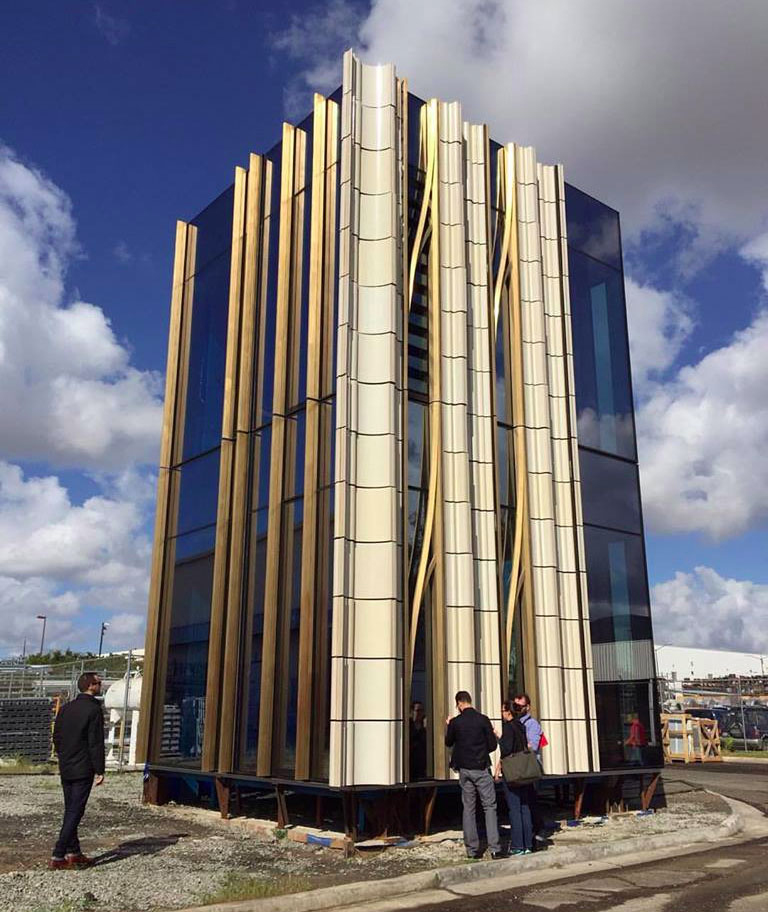In late October, PennDesign hosted a daylong series of panels on innovation in urban housing design, and the first one, “Super-Hot: High Pressure Economic Markets,” showcased some of New York City’s most spectacular and expensive new condos. There was Zaha Hadid’s West 28th Street residence—the $50 million penthouse is “still on the market, actually,” firm director Patrik Schumacher said—Herzog & de Meuron’s “Jenga Tower” at 56 Leonard, and ShoP Architects’ superskinny aerie on West 57th. Part of the symposium’s novelty was that it brought together architects, scholars, developers, and investors, or, as Barry Bergdoll, professor of art history at Columbia University and the first panel’s moderator, put it, “voices that generally speak separately.” This meant that the gorgeous renderings of New York City supertalls were interrupted by a PowerPoint presentation from Mark Willis, senior policy fellow at New York University’s Furman Center on Real Estate and Urban Policy, who noted that ultraluxury housing constitutes only 2 percent of sales in Manhattan.
It was a striking counterpoint, a reminder that the opening panel was dominated by such a tiny sliver of New York’s highly pressurized housing market, and during his moderating session, Bergdoll seized on it. “Is innovation only going to be at the top 2 percent of the market?” he asked. Chris Sharples, AIA, co-founder of SHoP, jumped in. “It’s really hard to finance affordable housing,” he said. To make it easier, “we need to break out of the conventional way of building. … High-end has more room to do that, and it should trickle down on affordable.” His fellow panelists nodded.
Sharples’ claim that innovation will “trickle down” from luxury projects to affordable ones inevitably brings to mind President Ronald Reagan’s discredited idea that cutting taxes for top earners generates wealth for those of us in lower income brackets. But perhaps it’s worth considering the claim more generously: after all, big budgets may enable designers to experiment more freely with expensive materials and technologies, and maybe, over time, these innovations will become cheaper and more relevant for less-expensive projects. At least, that’s the theory. Are there examples of innovation trickling down? Designers at Penn’s symposium quickly moved on to other topics, leaving that question unanswered.
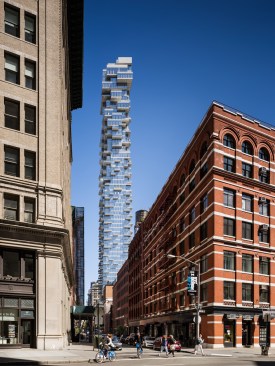
Alexander Severin
56 Leonard in New York by Herzog & De Meuron
Innovation Through Constraint
I called Michael Maltzan, FAIA, who won this year’s AIA Los Angeles Gold Medal, the chapter’s highest honor, partly because he has pioneered housing concepts for formerly homeless populations, and partly because he did not participate in the PennDesign symposium. He was skeptical that innovations can trickle down. “Perhaps they do,” he said, gingerly.
Maltzan said he thinks creativity emerges more from on-the-ground constraints, from “responses to very specific social, political, and economic lifestyle questions.” He cited his firm’s New Carver Apartments, one of four projects they’ve done with the nonprofit Skid Row Housing Trust. It’s a 97-unit, six-story building for formerly homeless elderly and disabled individuals, located immediately adjacent to the Santa Monica Freeway—or as Maltzan put it, “the round one.” The building, completed in 2010 at a cost of $18.4 million, has a unique cylindrical form which blunts noises from the highway. “The round cylinder was a direct result of trying to present the smallest amount of the façade to the cars as possible,” Maltzan said. In addition to managing acoustics, the circular design creates a central courtyard that hosts community spaces, and, as importantly, catches drivers’ eyes as they zoom past on the highway. “For that formerly anonymous community,” Maltzan said, “it is saying, ‘We are here.’ ”
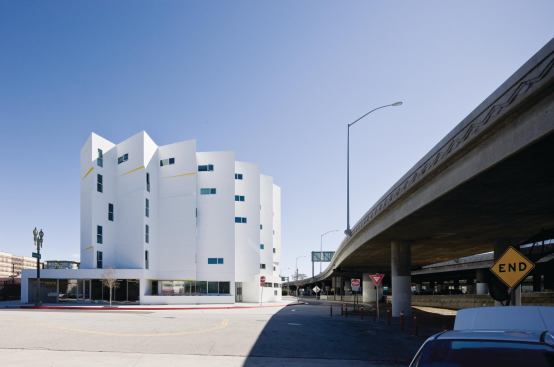
Iwan Baan
Maltzan's New Carver Apartments
As we spoke, I was struck by how many of Maltzan’s projects have required creative workarounds because of regulations. When the architect began designing the Star Apartments, another Skid Row Housing Trust project, completed in 2014 at a cost of $40 million, the city of Los Angeles did not allow multifamily prefabrication. It quickly became clear to his team, however, that prefab would enable them to build more quickly and therefore more cheaply. “The first thing we did was work with the city to create a pathway, to create a pilot project,” Maltzan said, for multifamily prefab. More recently, the firm’s Crest Apartments, which re-imagines LA’s “dingbat” style, in which a few floors of apartments sit over parking spaces, required similar negotiations. For the project, completed last year at a cost of $22 million, Maltzan and the Skid Row Housing Trust wanted to devote the first floor to a park rather than parking, as is traditional. “The building is still lifted up,” he said, “but the whole ground floor becomes a very porous, into the ground, outdoor community green space.” To enable this new take on the form, he and the Housing Trust convinced the city to reduce the parking requirements for the site.
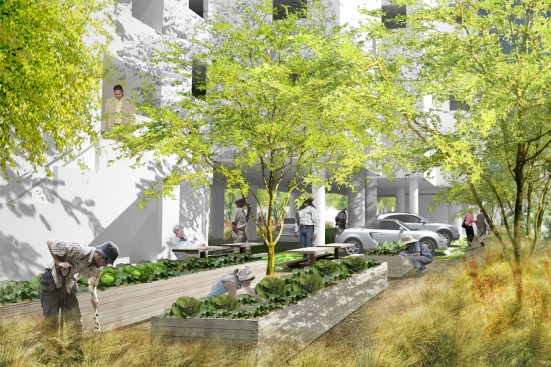
Michael Maltzan Architecture
A rendering of Maltzan's Crest Apartments
Oddly enough, Maltzan’s stories reminded me of the way that Chris Sharples of SHoP described his firm’s work when we spoke after the symposium. The key to design innovation, Sharples kept telling me, is “the process” rather than “the product.” SHoP spends about 12 to 15 percent of its budget on research and development, and Sharples said that most of this investment goes towards rethinking the ways the firm collaborates with the multiple teams that help build a building. “It’s how we negotiate relationships between trades, design, and construction process,” he said. Consider SHoP’s 57th Street supertall, the world’s skinniest residential building, whose delicate terra-cotta façade required close work with manufacturers. First, Sharples told me, the firm consulted with the manufacturers to learn more about the material. “Then, we developed models, and we shared these models with them, they came back with feedback, and we evolved the design based on how they’re going to fabricate. It’s a very circular, iterative process,” he said. Both SHoP’s superskinny tower and Maltzan’s residences with the Skid Row Housing Trust made difficult sites livable by challenging or changing habits, regulations, and norms through mundane, time-consuming back-and-forth between teams.
These iterative communications aren’t always smooth, of course, but even those instances underscore the importance of collaboration. Brian Phillips, AIA, principal of Philadelphia-based Interface Studio Architects, a lecturer at PennDesign, and one of the symposium’s organizers, told me about his firm’s 100K home. After the recession in 2008, Interface worked with developer PostGreen to design a 1,000-square-foot energy-efficient townhouse for just $100 per square foot. Keeping the price low required, among others things, an open floor plan with only one interior door. Buyers jumped at the contemporary design, but some had trouble securing a mortgage; banks thought the open plan was too risky. Phillips said that in some instances they built walls to satisfy the banks, and then tore them down after closing. “I feel very strongly that designers have their most intense potential to impact innovation in being able to speak the languages of the legal team and the finance team,” Phillips said. “There’s a lot of architects—frankly, there’s a lot of clients—who say, the architect is the artist. Let’s figure our stuff out, and we’ll call the architect to make it look nice.” Phillips believes it’s time for architects to rethink and broaden their role.
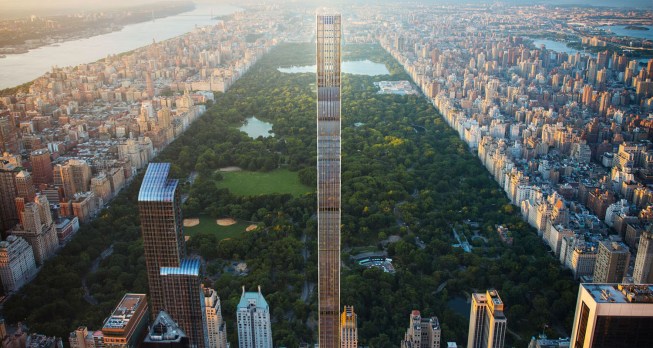
JDS Development Group
An aerial rendering of SHoP's West 57th Street supertall
A Question of Inequality
Which, perhaps, includes thinking more fully about how housing design intersects with today’s real estate market. Notably, no one I talked to managed to provide a specific example of innovation trickling down from luxury to affordable housing. Even Sharples seemed more interested in discussing collaborative processes than his trickle-down comment. But the rhetoric itself is timely. A few days after the PennDesign symposium, Patrik Schumacher, at the World Architecture Festival in Berlin, made news for a provocative but retrograde eight-point plan to remake urban housing through privatization and deregulation. (He was more conciliatory at PennDesign.)
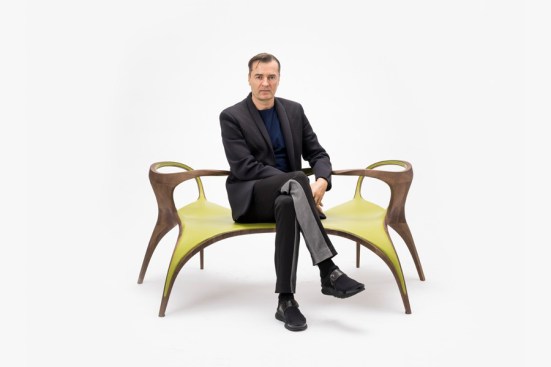
Martin Slivka
Patrik Schumacher
Does there need to be a relationship between high-end and affordable housing design? Maltzan told me he doesn’t think so. “It is interesting that this question of affordability, access, and class segregation is significant enough that it somehow pushes architecture and architects to try to justify their work,” he said. “I think architecture is broad enough to work with many different types of economies, and that’s okay.”
At a time when so many people lack access to good quality homes, perhaps the claims of trickle-down innovation reflect just how pervasive the problem of inequality is. Architects may want to play a greater role in alleviating unequal access to housing, and they might harbor an understandable unease with luxury projects at a time of increasing urban inequality, but that doesn’t change the way that innovation actually works.
